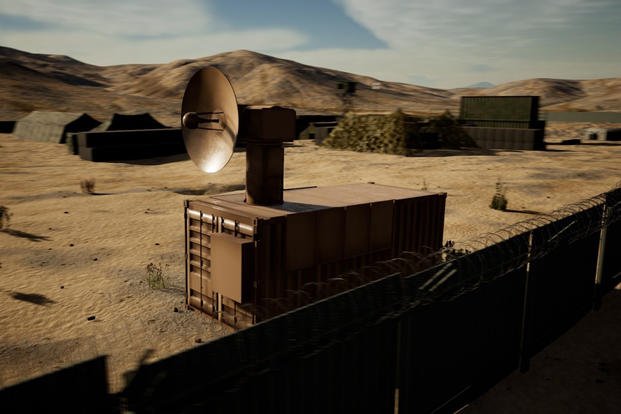India could fast-track the Israeli SMASH 2000 Plus systems to tackle drone threats like the one witnessed at the Jammu Air Force Station recently, according to reports.
In the early hours of June 27, two explosions were reported at the high-security technical area of Air Force Station in Jammu. The low-intensity blasts took place within a span of five minutes, causing injuries to two persons and some damage to a building.
Jammu and Kashmir police described the incident as a “terror attack” and federal agencies are probing the possible role of Pakistani terrorists.
India Today reported quoting security officials that two improved explosive devices (IEDs) were dropped by a drone. There were no fragments of the drone found at the blast site, with only splinters and remnants left of the explosives recovered.

“A drone was used only to drop the IEDs. Once the payload was dropped, the drone returned to wherever it came from”, a security official was quoted as saying.
This was a first-of-its-kind terror attack involving a drone. Earlier, drones were used by cross-border elements to drop narcotics and small arms in India’s Punjab and Kashmir regions.
On June 28, the Indian Army has shot down two drones suspected to be deployed by terrorists to attack an army base in the Kashmir Valley.
Israeli SMASH 2000 Plus
According to Hindustan Times, the Indian military has been testing the efficacy of the Israeli SMASH 2000 Plus systems. To counter the growing drone threats, India is now looking to acquire the Israeli system on an urgent basis.

The SMASH 2000 Plus is based on the SMASH 2000 system and includes an advanced Counter-UAS (Unmanned Aerial Systems) mode, which enables accurate “hard kill” capability. Its electro-optic (EO) sight system further offers a day/night rapid target acquisition capability, which enables the system to target small and rapidly moving aerial threats like combustible balloons and kites.
The SMASH 2000 was later upgraded to target small and fast drones from closer ranges of a rifle.
Last year, the Indian Navy had placed an order for an unspecified number of fire-control systems capable of countering the drone threats — the SMASH Fire control systems, manufactured by the Israeli firm Sharp Shooter.
Apart from the Navy, the Army and the Border Security Force had also reportedly expressed their interest in acquiring the SMASH Fire control systems.
Indian Navy is procuring Smash-2000 rifles as anti-drone equipment to protect against attacking drones: Navy Chief Admiral Karambir Singh pic.twitter.com/WAON6sDkSC
— ANI (@ANI) December 3, 2020
ThePrint reported the fire control systems will be installed mainly on AK-47 and AK- 203 rifles. With built-in targeting algorithms, the system can track and hit small drones flying at a high speed, at ranges of up to 120 meters.
“SMASH 2000 Plus provides an inimitable hard-kill solution against the growing threat of drones, and delivers proven ability to hit any ground or airborne targets and eliminate the threat quickly and effectively,” Michal Mor, the CEO of Sharp Shooter had said.
Countering Drone Threats
Over the years, many companies based in Israel and the US have developed anti-drone systems, comprising existing technologies such as radars, frequency jammers, optic, and thermal sensors.
Israeli defense company Rafael developed its own anti-drone system called the Drone Dome, reported The Indian Express. Similar to its Iron Dome missile system, which intercepts incoming missiles, the Drone Dome is capable of intercepting drones.
Capable of providing “a 360-degree coverage”, the drone dome is equipped with static radars, radio-frequency sensors, and cameras. It can easily jam the commands that are being sent to the enemy drone along with blocking visuals. It can also shoot high-powered laser beams in detailed precision to neutralize its target.
The US Anti-Drone Systems
The research wing of the Pentagon demonstrated a Counter-Unmanned Air System (c-UAS) multilayer defense architecture, reported The EurAsian Times. Known as the Mobile Force Protection (MFP) program, it can counter hostile drone intrusions.
WATCH: Israel Military Deploys High-Tech ‘Jaguar’ Robot To Patrol Gaza Border
The system is expected to guard moving convoys from smaller drones. The anti-drone system is equipped with X band radar to destroy the hostile drones, and with its advanced radar senses, identifies unmanned aerial system threats rapidly.
In the demonstration, the interceptors of the system were launched by a Humvee which tracked the drone and jammed the propellers of the target drone by shooting strong, stringy streamers.

The Defense Advanced Research Projects Agency (DARPA) mentioned that anti-drone program would focus on “defeating raids with multiple threats, rather than single unmanned aerial attackers”. It also stressed the development of an integrated solution of sensors, autonomy, and mitigation solutions.
According to 9News, the US is developing a futuristic weapon system, named THOR, which is equipped with a drone-killing microwave beam to halt the swarm of drones. The system uses short bursts of high-powered microwaves, enough to fry the electronics of the incoming hostile drones.
It can be easily placed inside a shipping container and can be moved to US bases around the world, the report stated. According to the US military, the THOR can be set up and operationalized in approximately three hours. A Prototype of THOR, also called the Tactical High Power Microwave Operational Responder was tested in Africa last year.
The Pentagon has also established the Army-led Joint Counter Small Unmanned Aircraft Systems Officer or JCO, to formalize the industry and technology into a single command and control system, reported Defence News.
In addition, plans are afoot to host two test demonstrations to evaluate the existing and future technologies, which may provide the JCO to choose the “best-of- breed” options to develop a far-reaching solution to the increasing threat of drones.
The JCO director, Maj. Gen. Sean Gainey stated, that the test demonstrations will provide the industry with the chance to “bring all of its low-collateral effectors to the range, and the team will choose the best systems from the demonstration to move forward with a joint solution”.
The Russian Anti-Drone Systems
Last year, Defence News reported that Russia was developing a helicopter drone to counter hostile UAVs. The Russian news agency RIA Novosti was told by the Russian military-defense complex that the new drone would “track down small and low-speed enemy drones at low and extremely low altitudes”.
Russia is also developing a new attack helicopter drone, according to reports from a Russian government publication, Rossiyskaya Gazeta. The drone reportedly weighs around 2.5 to 3 tons and has a range of 20-30 kilometers.
Along with the helicopter drones, it seems Russia also came up with a non-destructive way of catching UAVs, as reported by The Eurasian Times. A part of Russian Rostec Corporation, the Vega Company of Ruselectronics Group, developed the interceptor drone. The company is reportedly looking to patent the drone, which is equipped with a special net to capture its targets, the Russian News agency TASS had reported.
The Interceptor drone comprises a “body frame with at least two engines with variable angles of rotation placed along its perimeter”. Its aerodynamic structure also contains a catching net, which is completely integrated into the main body frame’s hollow space, the report stated.
Experts are of the opinion that interceptor drones may reduce the chances of destruction and debris, making them suitable for operation in crowded areas.
READ MORE
- Watch: The Ultimate Dogfight Between US & Russian Fighter Jets Over A ‘Top-Secret’ Air Base In Nevada
- Why India’s Ladakh Region Is Crucial For China’s Rise As An Economic Super-Power?
- 30 Times Faster Than Speed Of Sound: Is China Really Winning The Hypersonic Race With Its JF-22 Wind Tunnel?




